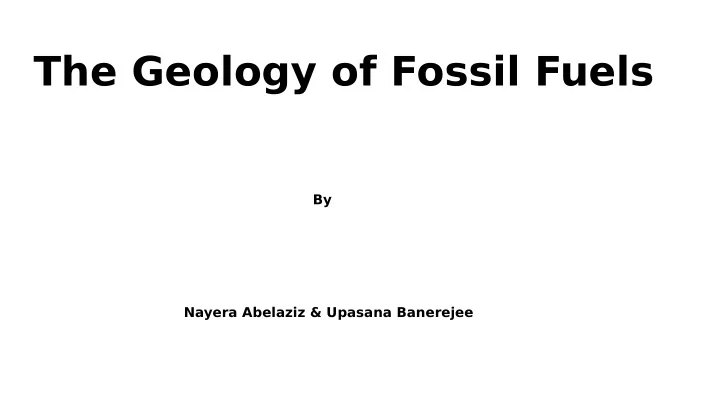

The Geology of Fossil Fuels By By Nayera Abelaziz & Upasana Banerejee
Geology of fossil fuels History of formation Physical structure and substance Process to make these usable
What are fossil fuels? Fuels formed by natural resources such as anaerobic decomposition of buried dead organisms. These were formed hundreds of million years ago, mainly in carboniferous period. (345-286 million years ago) Some deposits were found during late cretaceous period. (70 million years ago).
Types of Fossil Fuels Coal Oil Natural gas.
Origin of Coal In carboniferous period, land was covered with swamps fjlled with huge trees, leafy plants. As the trees and plants died, sank to the bottom of the swamps of oceans to form layers of spongy materials called peat. Over many hundred years, peat was covered by sand, clay which turned into sedimentary rocks. More and more rock piled on top of old rock and began to press on the peat. It was squeezed and eventually turned into fossil fuels.
Coal : Physical structure and substance Coal is made up of carbon, hydrogen, oxygen, nitrogen and sulphur. The three main types of coal are anthracite, bituminous and lignite. Anthracite coal is the hardest and has more carbon. Lignite is the softest and is low in carbon but high in hydrogen and oxygen content. Bituminous is in between anthracite and lignite.
Types of Coal (Metamorphic grade) Based on pressure applied to dead biotic materials 1. Peat is a fjbrous, soft, spongy substance in which plant remains are easily recognizable. It contains a large amount of water and must be dry before use. 2. Lignite is formed when peat is subjected to increased vertical pressure from accumulating sediments. 3. Bituminous Coal is greatly used in industry as a source of heat energy. 4. Anthracite is also known as "hard coal" because it is hard and has a high lustre.
Coal resources and reserves Quality Economics Safety
Geology of coal mining Underground mining : far beneath the ground surface, accessed by tunnels Surface mining : close to ground surface, accessed by excavation
Origin of petroleum and natural gas
Petroleum as a substance Yellow to black liquid found beneath earth’s surface Petroleum covers both naturally unprocessed crude oil and petroleum products separated by fractional distillation. Mostly recovered by oil drilling. Composition by weight Composition by weight (4types) Element Percent range Hydrocar Average Range bon Carbon 83 to 85% Alkanes Hydrogen 10 to 14% 15 to (paraffjn 30% 60% Nitrogen 0.1 to 2% s) Oxygen 0.05 to 1.5% 30 to Naphthen 49% Sulfur 0.05 to 6.0% 60% es Metals < 0.1% Aromatics 15% 3 to 30% remainde Asphaltic 6%
Petroleum geology Principally concerned with 7 key elements in the sedimentary basin: 1. Source (quantifjcation of organo-rich rocks) 2. Reservoir ( Unit with high permeability: Porosity check) 3. Seal ( Unit with low permeability: chalk, shale, evaporates: efgectiveness quantifjcation 4. T rap ( Ensuring position of reservoir and seal) 5. Timing ( Timing of hydrocarbon generation and expulsion) 6. Maturation (analyzing thermal history of source rock to predict timing) 7. Migration ( Analyzing how to safely move from source to reservoirs)
Petroleum production
Chemical Composition of Natural Gas Natural gas is a naturally occurring gas mixture, consisting mainly of methane. https://www.uniongas.com
Geology of Natural Gas Gas-rich shale is the source rock for many natural gas resources, but, until now, has not been a focus for production. Conventional gas accumulations occur when gas migrates from gas-rich shale into an overlying sandstone formation, and then becomes trapped by an overlying impermeable formation, called the seal. Tight sand gas accumulations occur where gas migrates from a source rock into a sandstone formation, but is limited in its ability to migrate upward due to reduced permeability in the sandstone. Coalbed methane does not migrate from shale, but is generated during the transformation of organic material to coal.
Natural gas Production
Further details about natural gas
Threat from fossil fuel
Information Sources http://www.ucsusa.org http://www.eia.gov/ https://www.wikipedia.org https://www.uniongas.com
Recommend
More recommend